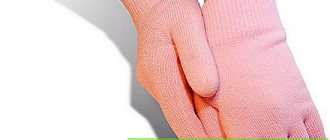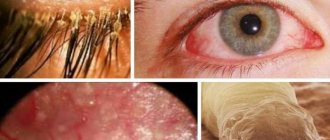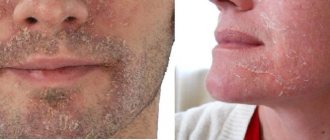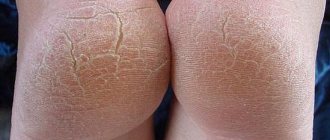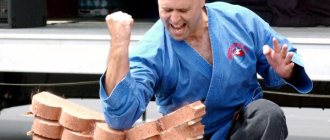If the skin on your feet is peeling, the most important thing to do is not to panic. This phenomenon is not so rare, and there are many proven methods to eliminate it. But first you need to understand why the peeling of the feet began, and only after that begin to solve the problem.
Causes of peeling feet
The dermis is an organ that serves as a reliable barrier against negative environmental factors.
When it starts to flake, peel, and itch, not everyone knows how to act and treat it. Every year the skin becomes thinner, does not retain moisture well and begins to crack and flake. The culprit is the process of disappearance of collagen fibers involved in the formation of the dermis. As a result, the water-lipid layer ceases to cope with its functions and a disturbance in the production of sebum occurs, the volume of water in the cells decreases, etc.
A healthy diet must contain a sufficient amount of vegetable oils, seafood, fruits and vegetables, and fish.
With the development of vitamin deficiency, the epidermis on the legs begins to dry out.
It is important to drink enough liquid up to 1.5 - 2 liters per day.
The foot may peel due to frequent consumption of coffee drinks, ready-made fast foods, alcohol and smoking.
Often the reason lies in an allergic reaction to cosmetics, materials, or food. Also, the skin of the legs can react to aggressive hair removal procedures - depilation, sugaring.
Skin peeling can develop due to a fungal infection. The whole foot or one toe or heel may be involved in the process. An additional symptom is itching. The patient requires consultation with a specialist. Fungal diseases are dealt with by a dermatologist who will prescribe a scraping and blood test. Cosmetic problems can develop as a result of the progression of exofoliative dermatitis, psoriasis, Kawasaki syndrome, eczema. It is the source that needs to be treated, not its consequence.
Infection and fungus are not the main culprits of peeling. A number of somatic diseases can send signals to the body in the form of cracks and dryness:
- hepatitis;
- diabetes;
- kidney pathologies;
- cirrhosis of the liver.
Steroid hormone medications can also cause peeling, even when taken for a short period of time.
Pregnancy provokes hormonal imbalances, and the skin on the feet can peel off and cause discomfort and pain.
If the skin on your feet is peeling, then the first thing you need to do is analyze the following points:
- Prolonged stay in a pond with the addition of bleach and other chemicals.
- Shoes, tights, socks made of artificial non-breathable materials. Such things do not allow oxygen to pass through, interfere with the normal respiration of cells, as a result, the local temperature and sole rise, and the foot begins to get wet.
- Dry indoor air during the heating season.
- Prolonged exposure to ultraviolet rays. A tan looks beautiful, but it causes dehydration, and the dermis can begin to exfoliate, burst and peel.
Proper therapeutic care and elimination of irritating factors will restore the beauty of your feet.
To improve the condition of your feet, you must follow these rules:
- Remove dead cells every day. Pumice will come to the rescue.
- It's good to dry your feet after a shower.
- Carry out contrast baths with vinegar, soda or lemon every day.
- Before applying cream or ointment, treat cracks with peroxide.
- After the procedures, apply the medicinal product.
An important condition is that the child’s skin must be treated with gentle preparations.
Why are your heels dry and rough - reasons
Have you been trying to heal your JOINTS for many years?
Head of the Institute for the Treatment of Joints: “You will be amazed at how easy it is to cure your joints by taking the product every day for 147 rubles ...
Read more "
The skin cells of the foot are exposed to heavy loads while walking, so they change their shape and are more likely to renew themselves and die. That's why you need to peel so often.
There are several things that provoke this phenomenon! 1. Insufficiently moisturized skin. 2. Clothing, shoes made of synthetic fabrics. 3. Long-term use of open shoes in the summer, or regular barefoot walks. 4. Lack of care for the skin of the feet. 5. Disturbance in metabolic processes. If the skin also turns yellow, then problems may be related to digestion. 6. Deficiency of vitamins A and E. 7. Use of antibacterial soap. 8. Dry air at home. 9. Narrow, uncomfortable shoes. 10. Fungus. 11. Mineral deficiency. 12. Reaction to sudden climate change. 13. Excessive tanning. 14. Frostbite. 15. Chlorinated water used in foot washing. 16. Insufficient fluid intake. 17. Constant stress and depression. In this case, nervous exhaustion of the body occurs, which is reflected on the skin. 18. Reaction to medications. 19. Iron deficiency anemia. Lack of hemoglobin, as a result, lack of oxygen.
Peeling skin, including on the heels, can simply be a symptom of the disease: 1. Dermatitis. 2. Erytoderma. 3. Eczema. 4. Psoriasis. 5. Excess of vitamin A. 6. Scarlet fever. 7. Rash. 8. Allergies. 9. Peeling skin syndrome.
Therefore, if heels are not the only problem, then you should consult a doctor to rule out these diseases.
Main reasons for the phenomenon
There are a number of different factors that can cause dry, peeling skin on your feet. The main causes of peeling feet:
- Insufficient hydration of the epidermis, leading to its drying out. Most often it peels off on the feet during the hot season, when the human body is constantly experiencing a lack of water. Also, the epidermis often dries out in winter, when skin moisture is greatly reduced due to exposure to heating devices.
- Wearing uncomfortable closed shoes made from artificial materials provokes impaired skin respiration, which often leads to dry skin and flaking.
- The skin will also peel off when wearing tights and socks made of synthetics. They not only disrupt the breathing process of the skin, but also negatively affect the functioning of the tissues of the foot. The negative impact of synthetic materials also often provokes peeling of the epidermis.
- Fungal infection of the skin is one of the most common causes of peeling. In this case, a person experiences severe itching in the area of the feet and an unpleasant odor of the feet. Such microorganisms most often affect people visiting public institutions, such as swimming pools, baths and saunas, therefore, while staying in them, you should use personal rubber shoes (slippers, flip-flops).
- Skin peels due to lack of vitamins and minerals. This process is especially active in the presence of chronic diseases and weakened immunity. In this case, peeling of the epidermis is often observed not only in the feet, but also in other parts of the body. Vitamin deficiency and hypovitaminosis also cause hair loss and brittle nails. Most often, peeling skin occurs due to a lack of vitamins A and E, which are involved in the process of skin regeneration.
- Prolonged exposure to hard and chlorinated water and some cosmetic detergents also leads to peeling of the epidermis.
- Ultraviolet radiation also has a negative effect on the skin of the feet, which often leads to burns of the epidermis.
- Peeling of the epidermis of the feet is also often observed in cases of disorders of the gastrointestinal tract and poor nutrition.
- Peeling of the epidermis of the legs is observed with constant stress, overwork and nervous tension.
Regular foot baths help remove dead skin
Why does the skin on my feet peel?
To understand the causes of peeling on your feet, you need to think about how often you take care of your heels. Skin renewal takes 3-4 weeks, but it is important to consider how easily the dead epidermis peels off. Women often use hand cream because they see that the skin on their hands dries out and cracks. The same thing happens with the feet. In addition, the surface of the feet bears a very large load when walking. The superficial layers of old skin protect the more delicate young ones from chafing. You've probably noticed that people who walk barefoot have very hard, rough skin on their feet; in a sense, it replaces shoes. If this is not your case, lubricate the skin on your feet more often.
People who do physical work have rough skin on their hands, with hard calluses on their fingers and palms. The same story with the foot: where the greatest load is concentrated, hard layers of skin appear. They can be cleaned off after a salt bath. Please note that peeling off all the old skin is even dangerous, because the renewed coating of the epidermis cannot withstand the load, and wet calluses may eventually appear. Walking with such fluid-filled blisters on the foot is very painful and uncomfortable. Relief occurs only after the callus is punctured and all the fluid is released.
As you can see, it is important not only to nourish the skin of the feet, but also to carry out systematic (but not total) cleansing and exfoliating procedures. The pathological effects of fungi on the feet should not be overlooked. Fungal infection of the skin, and then nails, has many varieties, so it is quite difficult to recognize this disease in yourself. It is better to consult a dermatologist and undergo painless tests. Remember that by curing fungi on your feet, you will protect other parts of your body and your loved ones from infection.
Treatment and prevention
In addition to traditional medicine, you can use cosmetic methods to soften your skin without leaving your home. They are suitable for both children and adults.
Ointments and compresses moisturize and nourish the skin of the feet of a child and an adult:
- Prepare two yolks, add a few tablespoons of warm oil (sunflower or olive) to them. Whisk the mixture well, apply to clean feet, wrapping them in plastic wrap. Put on socks, walk for an hour, then wash off.
- Take any foot cream, mix three spoons with 50 milliliters of chamomile infusion. Next, make a solution from starch: dilute two tablespoons of powder with water to make sour cream. Mix both solutions and spread it on your feet. Wrap your feet in film and put socks on top. Wash your feet well after half an hour.
- Prepare a few spoons of rich body cream, add a little freshly squeezed carrot or beet juice to it (you can even mix both juices). Apply the resulting mixture to your feet and wash them after 30 to 40 minutes.
Add table or sea salt to a bowl of warm water (not hot!). Approximately a spoonful of salt per liter of water. After dissolving it, place your feet in water for 15-20 minutes, treat your feet with pumice. Dry your feet well with a terry towel. At the end of the procedure, lubricate with a moisturizing or nourishing cream.
It could be chamomile, nettle, or calendula. Take one of the herbs or brew them all together. For a glass of boiling water you will need a spoonful of raw materials. After half an hour, the decoction can be used. For a liter of water, a glass of decoction. Keep your feet in this bath for 20-25 minutes. Natural ingredients soothe the skin and heal wounds. Afterwards, treat the legs with pumice stone and use cream.
For our miraculous bath, take a couple of tablespoons of salt and dissolve it in a liter of water. After the salt has completely dissolved, add a couple of drops of iodine. Daily use of this procedure will very quickly relieve you of this disease. Check out this article if you have peeling skin on your fingers.
Watch your health! Remember it is easier to prevent a problem than to treat it!
To prevent peeling of the skin on your legs, you should monitor its condition. To do this you need:
- Wash your feet every day and then apply nourishing cream to them.
- It is advisable to take warm baths every other day. You can add various herbs to them, for example: nettle, chamomile, calendula.
- Baths with lemon juice are excellent: 1 tablespoon of juice per 1 liter of water. Steam your feet for at least 20 minutes, then treat the skin with a grater or pumice stone.
- Doctors do not advise wearing tight shoes that are uncomfortable to walk in.
- Wear tights and socks made from natural fabrics. Drink enough fluids.
- Eat right, regularly replenish your body with vitamins and minerals.
- If gastrointestinal diseases are noticed, treat them immediately.
Treating the foot with anti-fungal ointment
Foot skin treatment is simple but long lasting. On the first day, it is advisable to start using steroid hormones. If the situation is not severe, you can buy antifungal ointment or cream. The drug of group B includes two active ingredients: one destroys the fungus, the second relieves itching and inflammation of the skin. Even when the illness has passed, you still need to apply it for another two weeks or even a month. Systemic therapy can be used, but it has a number of limitations.
Shoe care is the most important. It must be washed at a temperature of at least 60 degrees to kill all fungal spores. Boil and steam insoles to get rid of fungus in slippers and boots forever. Bleach also helps a lot when washing. At the end of treatment, after a month, it is advisable to throw out shoes and socks and buy new ones. It is worth remembering that fungus is a recurrent thing.
What to do if the skin of your legs peels off
Why does the skin on my heels peel off? This phenomenon is observed in almost a third of the adult population of the Earth. Most often, women are concerned about this problem, and men pay little attention to it.
At the same time, neglected conditions often lead to the appearance of painful and intractable cracks in the heels.
Why does peeling of the epidermis occur in this area? Its complete update is carried out in 3-4 weeks. During this process, cells located in the lower layers of the epidermis constantly divide and rise to its upper layers. Over time, they die and disappear. During the normal process of skin regeneration, no special peeling is observed.
With regular foot care using foot baths and exfoliating the epidermis using pumice or special graters, as well as with the constant application of special creams, the heels will always remain smooth.
To eliminate unpleasant symptoms, a number of measures are necessary to restore the functioning of the integument. Home care is one of the most preferred options among women.
No. 1 Mix the yolk of one egg with 1 tsp. butter. Add 2 tsp. grated potatoes and baby cream. Apply the mixture to pre-steamed skin and wrap with cling film and a warm towel. Remove the compress after 20 minutes. Repeat twice a week.
No. 2 A mint bath will help get rid of dryness and restore skin tone. To prepare it, you need to grind dry mint and mix it in equal proportions with calendula and chamomile herbs. Pour 1 liter. boiling water, leave to infuse for several hours. Pass the broth through a sieve and add to warm water.
No. 3 Heat 2 tbsp in a steam bath. spoons of honey. Combine with the same amount of olive oil. Dry skin is treated, every crack and wound. Leave the mask on for 20 minutes and rinse with warm water.
Pharmacy products
The pharmacy offers a wide range of products that will stop the skin on your feet from peeling.
The most popular of them:
- Extra. This cream will give freshness, disinfect, prevent fungus and unpleasant odor.
- Gehwol drug. Maintains water-lipid balance, suitable for sensitive skin.
- Refreshing balm. A good helper for outdoor enthusiasts. Relieves itching, refreshes, improves blood flow.
- Akriderm. Heel syndrome relieves ointment and cream. They relieve itching, eliminate allergies, inflammation and swelling.
If no infectious disease is detected, the doctor may prescribe vitamins.
If your heels are peeling, and not a single folk method helps, it’s time to go to a beauty salon. Professional treatment will bring quick results.
The specialist will perform peeling, which helps the keratinization to peel off. This is necessary so that new healthy skin can form on the damaged skin.
Next, the feet will be treated: paraffin therapy or chemical masks and procedures to increase moisture levels.
Massage: the entire foot, each toe, toe and ankle are worked out to improve blood circulation and the limb to receive nutrients and oxygen.
- Incorrect care. A trimmed pedicure, removing rough skin with a razor or filing away rough pumice stones give an instant illusion of well-groomed skin. As a result, you get perfectly smooth, soft heels. However, after a few days, the injured skin will begin to grow rapidly again, and then become rough and crack.
- Incorrectly selected shoes. Shoes that are too tight are harmful both to the foot in general and to the condition of the skin on the heels. Constant pressure on this area leads to deformation of the skin, the appearance of calluses and cracks. No less harmful are shoes that are too loose, in which the foot is not in a fixed state, which is why it constantly rubs, becomes rough and hurts very much.
Diagnostics
Only a dermatologist can accurately determine the cause of peeling and peeling skin on the feet. He will conduct a visual inspection and prescribe the necessary tests. Only after establishing the cause of this phenomenon can the necessary therapy begin.
Moisturizing your feet every day at night helps keep them healthy.
Signs of a fungal infection on the feet
Toenail fungus is the most common cause of cracked and flaky heels. If fungi have settled on your feet, the skin on your feet and between your toes will peel, peel, or crack, especially on the heel. Itching often develops. The spread of fungi to the nails leads to clouding, delamination, discoloration and destruction. Over time, the nail peels off from the bed and falls off piece by piece. It is clear that hardly anyone will consider a foot with signs of fungal infection of the epidermis and nails to be beautiful. At an early stage, fungi multiply in the surface layer of the skin; small bubbles filled with liquid or round spots with clearing inside can be seen on it. Treating a fungal infection is not easy.
It is better to trust the doctor, otherwise you have a high chance of not being fully treated and developing a chronic form.
Therapy
A dermatologist can determine the exact causes of peeling and peeling of the upper layers of the epidermis. During the diagnosis, the damaged feet are examined, and the patient undergoes the necessary tests. After identifying the cause of peeling skin on the feet, complex therapy is used. Among the therapeutic measures, a bath can be used. Sea or table salt is added to the water.
You can get rid of the problem of peeling using folk remedies using laundry soap (72% concentration). They need to rub their feet every evening. Then you need to put on socks (cotton or cotton) and go to bed. The next morning, wash your feet in warm water and apply moisturizer.
We also recommend reading: Why does the skin on my toes peel off?
- The skin of the feet is cleansed daily by using baths with table or sea salt or baking soda (1 tablespoon per 1 liter of water). After this, the keratinized epidermis is removed with a pumice stone or a special grater. After this procedure, a special moisturizing foot cream is applied to the feet.
- Rubbing your feet with laundry soap every night gives good results (72%). After this, cotton socks are put on your feet and left until the morning. In the morning, feet are washed with warm water and moisturized with cream.
- They take complex preparations that contain vitamins A, B, E, D and microelements (zinc, selenium, magnesium).
- They switch to a proper diet, which is rich in fresh vegetables and fruits, includes fatty sea fish, dairy products, and cereals.
- If a fungal infection is detected on the foot, the following external medications are used: Kanison, Lamisil, Mycospor, Batrafen, Exoderil, Lotseril. They are used only on the recommendation of a doctor.
How to deal with peeling yourself
We have figured out the causes of peeling. But women are much more interested in the question of how to deal with this trouble. We will talk about this below. Once again, I would like to note that if the cause of peeling is still unclear, you should consult a doctor.
- First of all, take care of good shoes that allow air to pass through and
allows the skin to breathe. Socks and tights should also be made of breathable natural fabric. You should not walk barefoot, as this increases peeling. Regular socks will prevent your heels from getting too rough.
- Choose a good vitamin complex. The body will receive the necessary vitamins and the skin will become better. In addition, you will support your immune system and get rid of other problems caused by vitamin deficiency.
- You need to take care of your feet daily. Make it a rule to pay attention to your feet every day, smear them with softening, moisturizing creams, and make foot baths with sea salt. Regular foot care is the most important rule. Use special exfoliating products and high-quality heel files. You can find good time-tested traditional medicine recipes that will help your legs look great.
- Now there are Japanese-made pedicure socks on sale, which are highly praised by women. The socks contain lactic acid, which acts as a good peeling. After using the socks, the skin comes off the feet on its own.
If you take all these measures together and regularly, then your heels and feet will quickly acquire an aesthetic appearance. It will be much easier for you to take care of your feet if you do this on an ongoing basis.
Locations
The dermis can peel off in different areas of the foot. Depending on the location, the cause can be determined.
If your heel cracks:
- avitaminosis;
- fungus;
- insufficient humidity in the room;
- contact with synthetics;
- uncomfortable shoes;
- age;
- chlorinated water;
- climate change;
- allergy;
- stress;
- taking medications.
The feet peel under the influence of the same factors, but diabetes and various endocrine disorders are added to them.
Why does the skin peel off on my toes? The problem occurs as a result of bacterial or fungal infections. Less commonly, the condition is provoked by allergies. The dermis may itch, turn red or yellow, and emit a foul odor.
Foot care
Socks for pedicure
Today, decorative cosmetics stores sell special pedicure socks. They are used in an innovative procedure that allows you to get your legs in perfect order at home without the risk and waste of time visiting an expensive beauty salon. The main components included in the composition are lactic acid and plant extracts of burdock, lemon, ivy, sage and other medicinal herbs. They stimulate the process of rejection of dead cells naturally.
If a symptom is detected, you must first make sure that there are no serious diseases, allergies or fungal infections. If there are no pathologies, and peeling is associated with increased dry skin, wearing uncomfortable shoes, then your feet need special care. The following procedures are effective at home:
- prepare the dough from 2 tbsp. lie liquid honey and 3 tbsp. lie wheat flour. Two cakes are formed, which are applied to the feet, previously steamed in hot water. Cover the top with polyethylene and put on socks;
- medicinal baths of water with the addition of apple cider vinegar (in equal proportions) quickly heal cracks and disinfect. After the procedure, be sure to lubricate your feet with a nourishing cream at night and put on socks. In the morning, keratinized skin can be easily removed using regular pumice.
The top layer of the epidermis must be removed daily with a hard abrasive file on a dry surface. Only then can the feet be steamed and smeared with nourishing compounds. To reduce the likelihood of fungus appearing after water procedures, feet should be wiped dry, paying special attention to the area between the toes. It is important to balance your diet by adding more fresh fruits and vegetables, meat, and cereals. A course of vitamins will help improve your skin condition. It is important to avoid stress, exercise and comprehensively strengthen the body.
Preventive measures
To avoid a repeat of the unpleasant situation when the skin peels off, doctors recommend:
- Avoid wearing tight, uncomfortable shoes.
- Increase the amount of clean water consumed.
- Treat exacerbations of chronic diseases in a timely manner.
- Wear underwear made from high-quality natural materials.
- Maintain a balanced, healthy diet.
Feet experience serious stress every day and it is not surprising that one day they begin to signal problems and lose their attractiveness. Cracked heels, dry, itchy and peeling feet require the right approach to treatment and care. In the fight, it is important to follow a complex that heals from the inside, helps old keratinizations peel off, and a new healthy layer grow in their place.
The article has been verified by the editors
Problem
Itchy skin can appear on any part of the body, but most often we experience it on the skin of the arms and legs.
It can begin at any time of the day, but it is especially unpleasant to experience itching at night, when it is most difficult for us to resist the urge to scratch the itchy area.
In addition, when we rest, the body produces less adrenaline and cortisone, but there is an increase in the production of the hormone histamine, which makes us feel itching even more. It can become a symptom of the development of an infection, in particular, foot fungus .
Effective folk remedies
Many people, both women and men, faced with a similar problem, do not know what to do and how to get rid of peeling. There are a large number of fairly effective folk remedies that help soften, moisturize the skin of the feet, and also prevent it from peeling. When choosing a recipe, you need to carefully study its composition. After all, the product must be used regularly, and it is very important that all ingredients are always available.
The most affordable way to treat peeling is to use laundry soap. For three days before going to bed, you need to thoroughly soap your feet and, without washing them off, wait until your feet dry. The soap should be washed off only in the morning. Baths using salt are useful. The procedure is performed every other day.
Milk foot baths
There are a large number of treatment methods from folk remedies. For example, foot baths. Add table or wine vinegar to the water. Place your feet in this container. After the procedure, your feet should be thoroughly dried. Use only disposable towels; if you don’t have any, you can boil a regular towel and socks. Boiling will kill the fungus. Next, soak the socks in the vinegar solution and leave overnight.
Vinegar can also be diluted with salt and water, or salt with water and soda. Saturated salt solutions should not be hot, but not cold either. Baths are made from plants:
- Lilac flowers are poured with vodka. They insist for two weeks. You can make lotions from this solution.
- Celandine herb has a beneficial effect on the results of treatment of all skin diseases.
- The mint herb is ground with salt and this paste is applied to the affected areas.
- Rowan leaves are also ground with salt.
Garlic also kills fungus. Dilute the garlic pulp with butter and apply to the wound surface. Salicylic ointment is a remedy available to everyone. For quick results, it is better to use 35% ointment. This strong ointment solution can burn healthy skin. But it removes all sores and keratinized tissue on the feet.
Homemade cream and balm
Daily rubbing of any natural oil on your feet - olive, grape, almond, peach or flaxseed - will help quickly get rid of peeling heels. While rubbing, it is useful to massage the toes and arch of the foot.
You can apply homemade nourishing creams. Prepare 1 tbsp. l. jojoba and cocoa oils, 2 tbsp each. almond, sea buckthorn and apricot oils, 1 tbsp. glycerin, ¼ tsp. melted beeswax and aromatic oils of mint, tea tree and lavender. Cocoa butter and wax are heated in a water bath. Glycerin and other vegetable oils are poured into this mass. After the mixture has cooled to 30 0 C, 3-4 drops of each essential oil are poured into it. Mix everything thoroughly and use.
If the skin on your heels begins to peel, then something is wrong with it. Get checked for fungi, get treatment, and then increase the number of cosmetic procedures for your feet. Don't forget about vitamin intake and proper nutrition. An active lifestyle and careful skin care will have a beneficial effect on the condition of your heels.
The root cause is fungus
The skin on the heel and ball of the foot will peel off. Ideally, the soles of your feet should be dry and warm. If it is too dry or too “hot”, then you need to check the thyroid gland. For example, shoes can be the cause of blisters. But bumps at the base of the thumb are more serious problems. The meridian of the pancreas and spleen passes through here. With such a pathology, it can be assumed that patients will suffer from pancreatic function and digestion will be impaired to some extent.
Fungus is a very common problem. He feeds where he is. Manifestations of advanced fungal infection on the sole, i.e. on the feet, is: itching, burning, cracks, redness between the toes, on the soles, changes in the color of the nail plates and already intense peeling of the skin on the feet. They become thin, loose or brittle, yellow in color or gray.
The edges of the nails are destroyed. Sometimes the periungual ridges become inflamed. In this case, you should definitely contact a specialist to conduct a specific study and prescribe adequate treatment for the foot. This is important because symptoms usually subside after a while. The process takes a protracted course, and the skin on the foot comes off in rags, periodically recurring. Such a patient becomes infectious to the people around him.
Symptoms
Since peeling and dry skin on the legs most often cause skin pathologies, it is advisable to consider the most specific symptoms for them as additional clinical signs.
Thus, symptoms will include:
- severe itching and burning in the lower extremities, most pronounced between the toes;
- the formation of small blisters filled with clear or serous fluid. In cases of special or accidental mechanical injury, they burst, which subsequently leads to the appearance of crusts;
- the appearance of red spots, which can be small and multiple or large, but localized in certain areas of the legs;
- violation of the integrity, deformation or change in the shade of the nail plates on the feet;
- unpleasant odor coming from the feet;
- dry skin;
- formation of large tubercles on the skin;
- increased sensitivity of the problem area to external stimuli and touch;
- pulsation in the affected area;
- expansion of the venous network, which gives the lower extremities a bluish tint;
- expression of spider veins and pinpoint hemorrhages;
- skin ulceration.
Spider veins on the legs
Such symptoms are specific, indicating the occurrence of one or another type of infectious process. If redness and peeling of the skin on the legs was caused by other ailments, then the clinical picture will additionally include the most characteristic symptoms for them.
